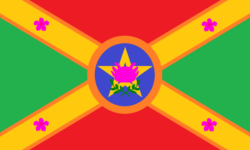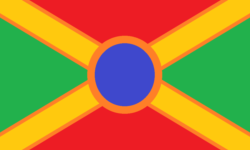Andrendia (Pacifica)
Axolotl Empire of Andrendia Impero Axolotl Di Andrendia | |
|---|---|
Motto: Uniti nelle differenze United in Difference | |
Anthem: [The Empire of Azaleas] | |
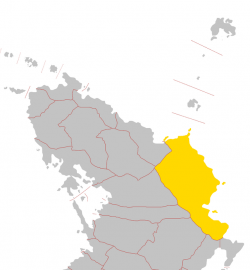 Location of Andrendia in Pacifica | |
| Location | North-East Bailtem between the Andreian Alps in the West and the Eastern Ocean (Tirriatico Sea) in the East. |
| Capital and largest city | Andreopolis |
| Official languages | Apennise |
| Recognised national languages | Austral
Aranzian Herculanean Portian |
| Religion (2022) | Azaelism 45,3%
Christianity 8% Cult of Axolotls 6,7% Islam 4,9% Not Religious/Atheist 35.1% Other 3,1% |
| Demonym(s) | Andreian |
| Government | Democratic Constitutional Empire |
• Emperor | Andrea Oloto VII |
• Prime Minister | Giacomo La Greca |
| | |
| Legislature | Parliament |
| Senate | |
| National Assembly | |
| Formation | |
• Unitication of the Pre-Axolian States | July 23rd 1496 |
• Creation of the Axolotl Empire of Andrendia | November 30th 1577 |
• End of the Andreian Civil War | July 20th 1807 |
| Area | |
• Total | 532,110 km2 (205,450 sq mi) (3) |
| Population | |
• 2022 census | 120,220,056 (2) |
• Density | 227.77/km2 (589.9/sq mi) (22) |
| GDP (nominal) | estimate |
• Total | $3,51 Trilion (7) |
• Per capita | $29,196 (23) |
| HDI | 0.869 very high · 14 |
| Currency | Andreian Brick (ABR/₿) |
| Time zone | UTC+2, +3 |
| Date format | dd/mm/yyyy |
| Mains electricity | 230 V–50 Hz |
| Driving side | right |
| Calling code | +39 |
| World Forum Code | AD |
| Internet TLD | .and |
Andrendia, officially the Axolotl Empire of Andrendia, is a unitary state in North-East Bailtem bordered in the West by Earamia, Arnchow and the CBR. The Country consists of a large land area between by the Andreian Alps and the Tirriatico Sea. It also owns 4 major islands and a few smaller ones located right off the coast of the Nation. It's the third largest and second most inhabited country in the South Pacific. The largest city is its Capital, Andreopolis.
The country is a Democratic Constitutional Empire and is currently ruled by Emperor Andrea Oloto VII, with Giacomo La Greca as the Prime Minister. The Official Language is Apennise, with Austral, Aranzian, Herculanean and Portian as National ones. The official religion is Azaelism.
Before the proclamation of Andrendia in 1577, the vast majority of the current territories of the nation was part of the Axolian Empire.
History
The history of Andrendia is divided by historians in 6 Eras, 7 including Prehistory.
Prehistory
Civilization in Andrendia started around 15,000 BC in the area around the Magazo Jungle. For thousands of years humans lived in nomadic groups until around 10,000 BC they started building villages. Around this time the oldest religion in Andrendia was created: The Cult of Axolotls, an endemic species of Andrendia. The followers of the Cult were called Axolians.
Ancient Era (Circa 10,000 BC-678)
Vulcanbonian-Axolandian War
Time passed and many small nations were formed, but this part of the Andreian history is really obscure since almost all information was destroyed around 678, when a war broke out between the biggest kingdoms of ancient Andrendia, the Vulcanbonian Kingdom and the Axoland Kingdom. The Vulcanbonian Kingdom worshiped the Gods of Mount Vulcanbon, a religion that believed in gods living on Mount Vulcanbon, an important volcano in Northern Andrendia. The Axoland kingdom was a kingdom of Axolians. This war was devastating. Almost all of the Countries involved and the Axoland and Vulcanbonian Kingdoms collapsed. The only other effect of the war was that the Vulcanbonian cult disappeared, leaving only its culture, and the Cult Of Axolotls became widespread across ancient Andrendia.
This event marked the end of the Ancient Era and the start of the Middle Era.
Middle Era (678-1387)
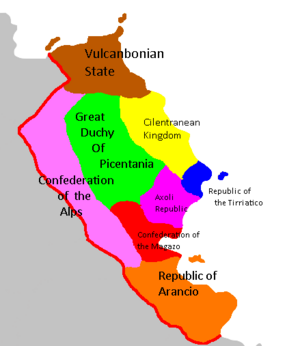
The aftermath of the Vulcanbonian-Axolandian War
In 1073 the chaos caused by the War ended and new stable powers formed across all of the territories involved in it.
The direct successors of the Vulcanbonian and Axoland Kingdom were the Vulcanbonian State, an almost anarchic territory, and the Axoli Republic, a nation reformed by parts of the Axolandian government that were inspired by the ideas of the Republic of Arancio.
Other countries that formed were:
- The short-lived Great Duchy of Picentania
- The Confederation of the Alps and the Confederation of the Magazo, two confederations of smaller states that formed after the war.
- The Cilentranean Kingdom, a monarchy that was ruled by a man that proclaimed to be a descendant of the gods believed by the Vulcanbonians.
- The Republic of the Tirriatico, a little republic with a great naval force.
Meanwhile, the Republic of Arancio, an ancient country located in the arid south, kept prospering by trading its resources with neighboring countries.
Early Axolian Era (1387-1496)
Transformation of the Axoli Republic into the Axolian Empire
In 1387, descendants of the Axoland crown took control of the Axoli government and proclaimed the transformation of the country into the Axolian Empire, with the plan of reuniting all of their ancient lands under their rule.
This event marked the start of the Early Axolian Era and of the Axolian Unification Wars.
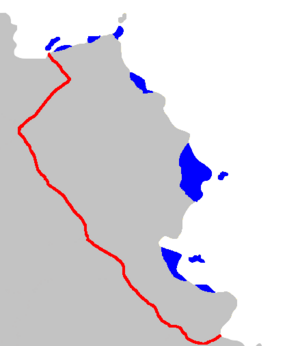
The maritime supremacy of the Tirriatican Empire
In 1403 the Republic of the Tirriatico transformed into the Tirriatican Empire and started colonizing the coasts of North-Eastern Bailtem.
The Empire also started trading with nations all over Pacifica, becoming one of the biggest traders on the planet.
Axolian Era (1496-1577)
The Unification under the Axolian Empire
In 1496 the Axolian Unification Wars ended, unifying almost all of the Nations that were located in the territories now controlled by Andrendia, diplomatically or militarily, under the Axolian Empire.
This event marked the start of the Axolian Era.
Early Andreian Era (1577-1798)
The Tale of Franco Oloto[1]
Then in 1577, the great explorer Franco Oloto started a journey in the northern part of the Axolian Empire. He saw an island off the coast from his ship and decided to explore it. He didn’t know, but that was the biggest decision of his life. On the island, that later he will call Azalea Island, he found a jungle full of strange Azalea trees, a strange find since Azaleas grow in bushes. Then in the middle of the island he found a ruined temple and there Azaleo appeared. Azaleo is the Flowering Azalea God, that in ancient times was worshiped by a mysterious civlization. Franco tried to touch the God, but his hand passed through him, he was just an apparition. Azaleo smiled and asked him to spread his cult back to Andrendia. He became the Messiah of Azaelism and reached the capital of the Axolian Empire, Axolia, and started talking about his find. A few started following him but many started attacking him and thinking he was crazy. Then the unthinkable happened. The Miracle of Axolia, where Azaleo appeared and took control over Franco Oloto to spread his word. This completely changed the Empire.
Some days later the Emperor was removed by the people and Franco became the first Emperor of the Axolotl Empire of Andrendia, called like this in name of his son, Andrea Oloto I.
This event marked the start of the Early Andreian Era.
Spreading of Azaelism across Andrendia
After the Miracle of Axolia, Azaelism became the national religion of the country and to spread it, from 1577 to 1604, the Azaleo's Squadroon, a religious group founded by Franco Oloto, started to spread Azaelism across Andrendia.
The Squadroon didn't force people into believing the religion, but still tried to spread it as much as possible.
There were many episodes where members of the group committed violent attacks against Axolians and other Non-Azaelists.
In 1604, after a massacre of Axolians that refused to believe in Azaelism caused by members of the Squadroon, Empress Maria Oloto I dissolved the group, proclaiming that the religion was present enough in the Nation and that atrocities like this were inhumane.
Andreian Era (1798-Present Day)
Invasion of the Republic of Arancio
In 1798 the last Pre-Axolian State, the ancient Republic of Arancio was invaded by the Empire after the Arancian border guard attacked a carriage that was taking Andreian diplomats to the capital of Val D'Arancio.
The war only lasted a month and it was a major Andreian victory.
The newly annexed territories became the Autonomous Region of Southern Andrendia, that, like Northern Andrendia, received its autonomy due to its long history of independence from powers coming from the Great Andreian Plains.
This event marked the start of the Andreian Era.
The Dark Ages of the Andreian Era
"The Dark Ages of the Andreian Era" is a term used to define the rule of Emperor Franco Oloto III.
During his rule, the emperor installed many policies that limited the belief in the Cult of Axolotls, the autonomy of the regions and many of the people's freedoms.
Living in this period of history is often defined as one of the worst times to live in Andrendia.
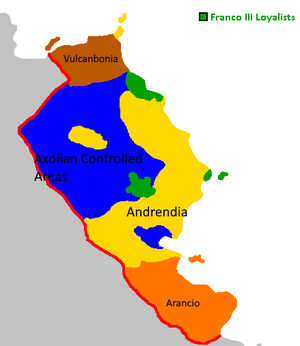
Andreian Civil War
On July 14th 1802 Andrendia saw the start of a civil war. After the many tensions between the Axolian population and the Empire, the Emperor Franco Oloto III was killed by an Axolian extremist.
The war was fought between five different factions:
- The Axolian Faction, tired of the Emperor's policies, they wanted to take control of Andrendia and get revenge on the Azaelists.
- The Andrea Oloto IV Supporters, who supported the government of the new emperor and wanted to bring peace back to the nation.
- The Franco III Loyalists, who believed that the Emperor was right and held power only in small but fortified areas.
- The Arancian and Vulcanbonian Independentists, that after the removal of their autonomy wanted their Independence back.
Immediately after the assassination, Axolians started to rebel and take control of large areas of the country. Meanwhile the new government rushed to stop the rebels and took immediate control of Azalea Island, to stop the likely planned devastation of the Temple.
On December 22rd 1802 Northern and Southern Andrendia declared Independence from the Empire and started fighting against both the Empire and the Axolians.
Then from the March of 1803 to the February of 1804 the worst event in the War happened. In the pocket of land in Picentania controlled by the Empire in the Axolian territories massive attacks happened, mostly killing civilians. The survivors of the attacks were then took to the biggest city near the Exclave, Collinetia, to be tortured and killed. Houndreds of innocent people were killed in the city. Collinetia would be renamed Picentia after the war in name of the civilians that lost their lives in the city.
On February 4th 1804 a massive attack from the Empire attacked the city, discovering and stopping the massacres. Axolian generals declared that this was a revenge for the attacks made by the Azaleo's Squadroon against Axolians.
On the 1st of May 1804, on the coast of Cilentranea, Emperor Andrea Oloto IV signed a peace declaration with the Franco III Loyalists, that joined the Empire and started helping it to stop the Axolian Faction and the Independentists.
During all of 1805 the Empire made countless attacks in Vulcanbonia to stop the secessionists, capturing their capital and annexing them on October 17th.
Then on January 8th 1806 a delegation from Arancio sent a request to reunite with the Empire, but keeping their autonomy. The Empire accepted the request.
On the 15th of July 1807 the Great Battle of Andreopolis was fought. The Axolians attacked Andreopolis on the first lights of the day, surprising the population. They burned the Emperor's Palace and destroyed many Azaelist Churches. Some hours later the Empire's counterattack devastated most of the Axolian army and then emperor Andrea Oloto IV killed the leader of the Axolian Faction, after he shot him in the arm.
Finally on the 20th of July 1807, the Emperor signed a peace treaty with the generals of the Axolian Faction declaring the complete reunification of Andrendia and the end of the war.
All of the policies created by Franco Oloto III were nullified and autonomy was restored in Northern and Southern Andrendia.
Andrendia after the Civil War and onwards
On December 3rd 1839, the first railway in Andrendia, the Trenia-Andreopolis railway, was opened.
In 1860 the Great Reclamation Project started, removing the entirety of the Swamps in the Great Andreian Plains.
In 1864 Andrendia partecipated to the negotiations of the Grovne Conventions.
On March 9th 1921 the recently on power Emperor Franco Oloto IV, known as the Great Reformer, installed new economic policies, following the socialist ideals he heard of during his youth. This decision made him very loved between workers.
On August 23rd 1925 the Block River Dam was completed, the area that became the Block Dam Lake completely filled with water in 1949.
Through the entirety of the Great War, Andrendia remained neutral. The decision made to maintain diplomatic relations with both sides of the war.
On 15 February 1973 Franco Oloto IV founded the Andreian Space Agency and some day later, after a National Referendum, Andrendia joined the CPSC.
Geography
Physical Geography
Andrendia has a variety of environments, from enourmous mountains to calm plains, from great jungles to arid mesas.
The major mountain range are the Andreian Alps, full of volcanic activity, the mountain range has some of the highest mountains in Bailtem, like Mt. Brick and Mt. Block. Located on the west of the nation, this mountains always signed the borders of the Empire.
In the northernmost part of the mountain chain is present the enormous Mt. Vulcanbon, the volcano is not as high as the other peaks of the mountain chain, but is twice as volcanically active.
Going south, we find the Arancio Mesa, an arid and resource rich area full of eroded peaks and flat hills.
The rivers that form from the glaciers of the mountain chain form the Great Andreian Plains, the most inhabited area in the nation. In the past this area was full of swamps and lakes, but many reclamation projects made the area habitable. But humans didn't only remove water, but also move it. The Block River Dam is the biggest of the country and produces energy for all of the surrounding areas, including the capital of Andreopolis. The dam generated the Block Dam Lake, the biggest in Andrendia.
The southern part of the plain is occupied by the Magazo Jungle, the biggest Jungle in Andrendia and a protected area.
Going East we reach the Tirriatico Sea, that goes from the coasts of Andrendia to the great trenches that surround Bailtem and the other continents of the South Pacific.
Political Geography
First Level Subdivisions
The Country has 11 first level subdivisions: 2 Autonomous Regions, 3 Island Regions, 5 Standard Regions and the Imperial Region of Capitalia, which houses the capital of the country, Andreopolis and its metropolitan area.
Standard Regions
Andro
Andro, commonly known as the Mountainous Frontier, is the Westernmost region of Andrendia. The region is almost entirely occupied by the highest peaks of the Andreian Alps, with only a few flat areas on the eastern part of the region. In this area are located the largest inhabited centers of the region, the capital of Azalì, known for its beautiful Azaelist Church, and the town of Picentia, named after the Picentanian Azaelists deported there during the Civil War. The third biggest town in the region, Valle Aurea is located in the hilly area of the region, on the Aureo River, main tributary of the Picentino River.
Brickia
The region of Brickia is the most inhabited in the Country, thanks to its large plains and water presence. The main cities in the region are Faiano, the regional capital and largest producer of the Andreian Potato, Trenia, home of the Andreian Railways, and Eolia, famous for its large wind power industry. The region is crossed by the two major rivers of the nation: the Brick, which flows to the national capital and then into the Sea, and the Block, that stops at the Block Dam Lake, a lake located in what once was the Central Brickian Depression, turned into a lake by the Block River Dam, that supplies the region with energy. The river then flows into the Brick via artificial canals.
Cilentranea
Cilentranea, smallest of the Standard Regions, is located on the coast between Capitalia and Picentania. The region has large sandy beaches, that attract a lot of tourists, main source of the regional wealth. The main inhabited centers are the capital of Cilentina, touristic city located on the mouth of the Picentino, and Granporto, ancient capital of the Tirriatican Empire and largest port in the country.
Picentania
The region of Picentania is a mostly flat region located between Northern Andrendia and Brickia. The region is named after its main river, the Picentino. The main inhabited centers are Pontinia, regional capital and location of an ancient arch bridge, Sala, an agricultural town famous for the production of the Picentanean Cheese, and Val Fiumara, located where the Aureo River joins the Picentino.
Magazena
The Magazena Region is named after the Magazo, a river that flows into the Gulf of Axolotls, the largest gulf in the nation. The region is covered by the largest jungle in the country, the Magazo Jungle. The areas not covered by the jungle are where most of the population is located. The main inhabited centers are Pastoria, the capital of the region and large wool producer, Fabraica, the industrial heart of Andrendia, located on the hills near the border, and Axolotlia, main port in the Gulf of Axolotls.
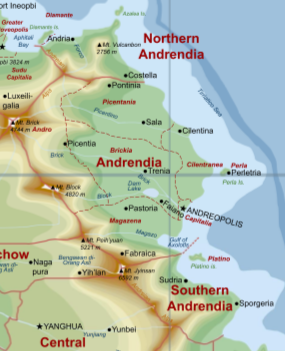
Island Regions
Diamante
The island, located off the coast of Northern Andrendia, is home to a large diamond mine that provides great wealth to the region. There aren't large inhabited centers on the island, with only the small village of Diamantia. The main attraction of the village is the Diamond Mining Museum, where the history of the island's diamond mines is preserved.
Perla
The island Region of Perla is famous for its sparse jungle and is based economically on fishing, pearl collection and tourism. The largest inhabited center is the town of Perletria, where there is a large center for the collection of pearls and the national aquarium.
Platino
This region, located off the coast of Magazena and Southern Andrendia, is known known for its metal rich, especially in platinum, craters, created by an ancient asteroid impact. The only inhabited center on the island is the town of Platiniano, home to the Andreian Space Agency and its equipment. An astronomical observatory is also located on the island.
Autonomous Regions
Northern Andrendia/Vulcanbonia
The Autonomous Region of Northern Andrendia, also known as Vulcanbonia, is home to the largest volcano in the Empire, Mount Vulcanbon. The mountain divides the region in half. In the Western part, large maritime pine forests occupy most of the environment. The eastern part, on the other hand, is very similar to Cilentranea. The main inhabited centers are Costella in the East and Andria, the regional capital, in the West, on the mouth of the Forco River. In the northernmost part of the region is located the small town of Punta Azalea. Off the shore of the town is located Azalea Island, location of the mysterious Azalea Temple and other ruins of the still unknown to this day civilization that inhabited the island. Due to the religious correlations of the island with the Azaelist religion, the island is a place of worship and pilgrimage.
Southern Andrendia/Arancio
The Autonomous Region of Southern Andrendia, also knwon as Arancio, is home to the largest desert in the country. The region's secondary name comes from the color of the large mesas located in the region's center. In the south of the region, the coast becomes extremely steep and rocky. The main inhabited centers are Sudria, the regional capital, located in the less arid area of the country, Sporgeria, locatred on one of the steep cliffs of the region and Val D'Arancio, ancient capital of the Arancio Republic, located in the mesas. Going south from the regional capital, the climate becomes hotter and the environment transforms from a plain to a large prairie full of shrubs and cacti. Around the center of the region, the praire becomes a desert, famous for its giant Mesas. The desert is extremely resource rich, especially in oil and natural gasses, that are the main source of the region's economy.
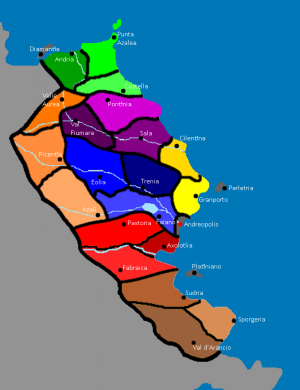
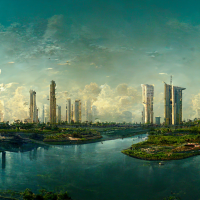
Imperial Region of Capitalia
The Imperial Region of Capitalia is a Special Region comprising the National capital of Andreopolis and the sourrounding metropolitan area.
Second Level Subdivisions
Every First Level Subdivision in Andrendia, with the exceptions of the Imperial Region of Capitalia and the Island Regions, have Second Level Subdivisions, known as Provinces. There are a total of 20 Official Provinces in the country. The Regions without Provinces, due to also serving the roles a province would alongside their Regional ones, are counted as Special Provinces, taking the total amount of Provinces to 24.
| Region | Provinces in the Region | Regional Capital |
|---|---|---|
| Andro | Province of Valle Aurea, Province of Picentia, Province of Azalì | Azalì |
| Brickia | Province of Eolia, Province of Trenia, Province of Faiano | Faiano |
| Capitalia | Special Province of Andreopolis | Andreopolis |
| Cilentranea | Province of Cilentina, Province of Granporto | Cilentina |
| Diamante | Special Province of Diamantia | Diamantia |
| Magazena | Province of Pastoria, Province of Fabraica, Province of Axolotlia | Pastoria |
| Northern Andrendia/Vulcanbonia | Province of Andria, Province of Costella, Province of Punta Azalea | Andria |
| Perla | Special Province of Perletria | Perletria |
| Picentania | Province of Fiumara, Province of Pontinia, Province of Sala | Pontinia |
| Platino | Special Province of Platiniano | Platiniano |
| Southern Andrendia/Arancio | Province of Sudria, Province of Sporgeria, Province of Val d'Arancio | Sudria |
Economy
The Andreian Economy is partially based around a Socialist model.
The Nation's economy is led by Tourism, Ore Extraction, Agriculture, Electronics and Oil and Gas Extraction.
The historic and natural beauties of Andrendia make tourism the biggest economic resource of the Nation.
The Platinum and other Rare Metals extraction on Platino Island and the Diamond Extraction on Diamante Island make Ore Extraction a dangerous, but very useful, resource for the economy.
The Oil and Gas extraction sites in the Southern Mesas are one of the most important economic and energetic resources of Andrendia.
Culture and Population
Religion
The National Religion is Azaelism. This Religion was "funded" by the first Emperor of Andrendia, Franco Oloto I, but historians today think the Religion is way older, due to the age of the temple on Azalea Island. To this day, who the inhabitants of the island were, what happened to them and how Franco Oloto rediscovered the religion is unknown. Even is the majority of the Andreian polutation is religious, Religion isn't as prevalent in daily life as in the past. Other Religions present in the country are the endemic Cult of Axolotls, Christianity, present especially in the Aranzian inhabited areas, and Islam.
Almost 40% of the country's population is Atheist/Non-Religious.
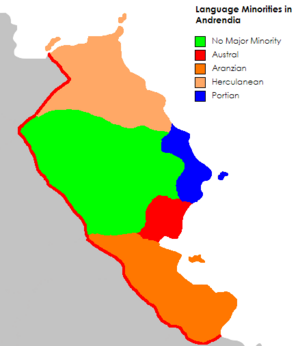
Languages
The Official Language of Andrendia is Appenise, with Aranzian, Portian and Herculanean as National Languages. Austral is also recognized as a National Language, due to the big Austral speaking minority in the "Austral Belt", located between Capitalia, southern Brickia and eastern Magazena.
Food
Typical Andreian dishes are the Andreian Mashed Potatoes, made with an ancient recipe from Faiano, and the Picentanean Cheese, produced with the milk of the cows of Picentania following a production method with unknown origins.
National Symbols
The National Animal of Andrendia is the endemic Axolotl, existing in the country for millions of years and being venerated, even to this day, by the Cult of Axolotls.
The National Flower and Plant is the Azalea, specifically the Andreian Azalea, flower with extremely important religious symbolism to the Empire, due to Azaelism being its major and Official Religion. Andreian Azaleas are endemic to Point Azalea and Azalea Island, where huge bushes of them are extremely common in the small jungle that covers the two areas.
Regional Symbols
Each Region of the Empire has a Regional Symbol, varying from Natural Beauties to Buildings to Food.
Andro
The Regional Symbol of Andro is Mount Brick, biggest and third highest peak in Andrendia.
Brickia
The Regional Symbol of Brickia is the Andreian Potato, local breed of Potatoes that grows in the southern part of the Region.
Imperial Region of Capitalia
The Regional Symbol of Capitalia is the Imperial Palace of Andreopolis, home of the Emperor, that started its construction in 1601 and got countless renovations across the duration of the Empire, with the biggest ones being the one started by Andrea Oloto III and the one done by Andrea Oloto IV after the Mansion was burned down during the Civil War.
Cilentranea
The Regional Symbol of Cilentranea is the Tirriatican Castle, located in Granporto. The castle was the historical house of the rulers of the Tirriatican Empire. The descendants of the last rulers of the Empire turned the Castle into a museum.
Island Region of Diamante
The Regional Symbol of Diamante is the Diamond of the Century, the largest diamond ever found in the Island's mines. It's called like this because it was found during the last week of 1899.
Magazena
The Regional Symbol of Magazena is the Magazo Jungle, biggest jungle in all of Andrendia and home of the majority of the Country's Axolotls.
Autonomous Region of Northern Andrendia/Vulcanbonia
Vulcanbonia has two Regional Symbols. The first one is the Mount Vulcanbon Complex, an ancient temple complex located on the western side of Mount Vulcanbon. The second one is the Azalea Complex, the complex of ruins on Azalea Island that include the Azalea Temple. Both ruins seem to come from the middle of the Ancient Era.
Island Region of Perla
The Regional Symbol of Perla is the endemic bird of the island, the Perlian Parakeet. Like other species of Parakeets this bird isn't very large. The birds are famous for their colored feathers and it's illegal to hunt them or own them as pets, since they're an endangered species.
Picentania
Picentania also has two Regional Symbols. The first one is the Pontinia Bridge, a large stone arch bridge built in the town's deep valley during the rule of the Great Duchy of Picentania, to connect the two villages that then became Pontinia. The second symbol is the Picentanean Cheese, produced all across the Region's plains.
Island Region of Platino
The Regional Symbol of Platino is the Platino Crater, a large impact crater created by a prehistoric asteroid impact that devasted the area, donating it of its now useful rare metals.
Autonomous Region of Southern Andrendia/Arancio
The Regional Symbol of Arancio is the ancient city of Aranzia. This ruin complex located in Val D'Arancio is composed by the remains of the Ancient capital of the Republic of Arancio. The most recent ruins in the complex date back to the late Middle Era, when the town was abandoned after an earthquake and rebuilt in the current location of Val D'Arancio.
Population
Andrendia has a population of 120.220.056 inhabitants unequally divided across the nation.
| Region | Population | % |
|---|---|---|
| Brickia | 25.246.212 | 21% |
| Picentanea | 22.721.591 | 18,9% |
| Capitalia | 18.634.109 | 15,5% |
| Magazena | 15.628.607 | 13% |
| Cilentranea | 12.623.106 | 10,5% |
| Northern Andrendia | 10.218.705 | 8,5% |
| Andro | 9.016.504 | 7,5% |
| Southern Andrendia | 5.530.122 | 4,6% |
| Perla | 360.660 | 0,3% |
| Platino | 180.330 | 0,15% |
| Diamante | 60.110 | 0,05% |
| Total | 120.220.056 | 100% |
Trivia
- The current Axolotl population of Andrendia is over 1.500.000, with the most living in the lakes of the Magazo Jungle.
- Mount Block is named after the salt crystals that are found under the mountain, found in shapes similiar to cubes and blocks.
- In Apennise, some of the Mountains, Rivers and even one of the Regions and the Currency have different names, here's a list of the differences.
| Austral Name | Apennise Name |
|---|---|
| Mt. Brick | Mt. Bricco |
| Mt. Block | Mt. Blocco |
| Brick River | Bricco River |
| Block River | Blocco River |
| Brickia | Brichia |
| Brick (Currency) | Bricco |
Notes
- ↑ Some parts of this section may not have really happened, most of the real story of what happened on Azalea Island is currently a mystery, the only information we have comes from the Book of Azaleas.
